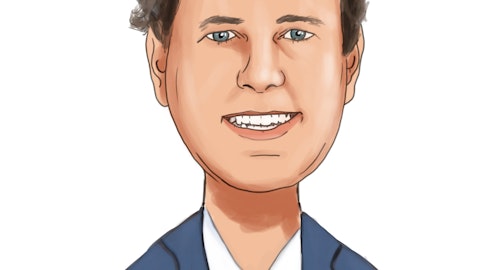Tom Hennigan: Bryce, with the 8%, when we’re looking at our maturities at the end of ’24, we wanted to be measured and not put our eggs in one basket and wait for the market to rebound. So we consider this kind of step one in addressing these upcoming maturities. 8.2 for the market was a good rate, but candidly, not a rate we wanted to stick with for any long-term amount of time. So felt the right thing to do would be to swap that to floating, certainly seeing the likelihood that base rates are going to come down. So over time, paying much less than the 8.2, and that’s at least where the rate curves are going to go. That’s what we anticipate happening with that instrument. And in terms of the next step is we’re going to look to do potentially an index eligible deal, whether it be later in ’24, early ’25, increase our overall unsecured debt exposure, that’s something that we’ll be — we’re working on and looking, we’ll say, in the — over the course of the next year.
Operator: And our next question comes from the line of Finian O’Shea from Wells Fargo Securities.
Finian O’Shea: Aren, I appreciate the portfolio cover as it relates to the core middle market strategy and opportunistically partaking in the larger market and/or ARR deals. So in these instances, does that mean the direct lending platform that serves the BDC under you is opportunistically doing other styles? Or is it that the BDC complex is claiming this deal flow from other Carlyle credit verticals? And then second part there, are you still dedicated to the core middle market? Or are you drifting up market by design?
Aren LeeKong: So let me start from the first question, which is a great one. So our knitting is core middle market. So if you think about the — for our entire platform, that’s a great question. If you think about the median EBITDA of a company that we lend to, it’s about $76 million. With that said, we have a pretty big — and this is all within direct lending and the private credit business. We have a large origination footprint. So for us, when I think and the team thinks about direct lending, my ultimate goal, and I’m going to go back to the previous question is we’re putting together a big portfolio with the average position being less than 1%. So my ultimate product is the cash flow stream that kicks out. So in the first half of last year, when there were a lot fewer transactions to be had, it was the first time in many years where, quite frankly, the term on the upper part of the market, so well north of $100 million of EBITDA.
We were able to get spreads that were on top of the mid-market. So call it, 675, 700. We’re able to get covenants, and we were able to get terms that were the same. So from a risk standpoint, in the first half of the year, opportunistically, we’re able to do direct lending. And we had to make a choice for our investors what is the safe — what is safer. If I can get similar terms, similar protections and similar spread to the mid-market and actually have the protection of a much larger business with who historically hasn’t had those covenants and hasn’t have those protections, we opportunistically went upmarket. By the second half of the year, and you and I have talked about this behind closed doors as well as the upper part of the market got a little bit more crowded, CLO bid came back, significant retail flows went into other direct lending strategies and some of our peers, we skewed back down to the core mid-market.
So — and that core mid-market, again, I’ve defined as somewhere between $25 million — in the second half of the year, probably $25 million and $75 million. The point on ABL strategies, we do have a team focused on asset-backed lending. And when we think about asset-backed lending, it is to core middle market companies. But as opposed to being structured as a cash flow loan, we are literally thinking about our downside protection being true assets, receivables, cash, et cetera, real estate. And then we have obviously, a very big software practice who also reports up to me. And that team opportunistically has done some ARR deals. We are, quite frankly, been probably less exposed to ARR than some of our peers. But again, my goal and this doesn’t sound — this is going to sound sexy.
My goal is how do you get overpaid for taking less risk? So again, we’re focused on direct lending. Once in a while, if I can go upmarket, if that market is dislocated, we do it, and we did it first half of last year. Today, we’re probably more focused on the mid-market though, opportunistically, we do go upmarket if something is attractive. Hopefully, that answers the question.
Finian O’Shea: Yes, very much. And to get back to Dermatology Associates. Sorry if I missed any of this part of the dialogue, but it sounds like you just took control or received control. But this, of course, had been a long challenged credit, where you had restructured the debt somewhat previously. So can you give some more color on the state of the investment now? Do you plan to put more money into it or maybe immediately bring in a new sponsor partner? And then has the EBITDA trajectory stabilized? Or is it still in decline?




